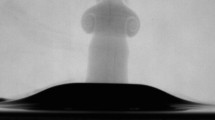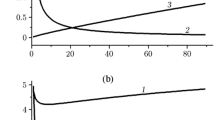Abstract
Models based on mass diffusion theory successfully represent the growth and collapse of gas bubbles in an epoxy resin. Solution of the steady-state diffusion equations requires measurement of the diffusion coefficient and solubility of the mobile species within the resin pre-cursor. These parameters are affected by changes in temperature and/or pressure and are generally not measured as part of a processing schedule. Models have been evaluated that predict the prerequisite driving force in terms of a concentration gradient and the interaction with the processing variables from the chemistry of the resin molecule. A solubility parameter approach has been used to estimate the solubility of gas in the resin in conjunction with regular solution theory. The surface tension forces, which also play an active role in bubble stability and dynamics, have been estimated from molar attraction constants.
Similar content being viewed by others
References
D. Hull, “Introduction to Composite Materials”, (Cambridge University Press, 1981) Ch. 7, p. 145.
J. R. Wood, PhD thesis, University of Surrey, UK (1992).
J. R. Wood and M. G. Bader, in “Proceedings of 8th International Conference on Composite Materials”, Honolulu, HA, USA, 10 May (1991) pp. 1–9.
Shell Resins, “Epikote Technical Manual”, E.P. 1.1.12, 3rd Edn (1987).
H. Batzer and S. A. Zahir, J. Appl. Polym. Sci. 19 (1975) 585.
K. Ravindranath and K. S. Ghandi, ibid. 24 (1979) 1115.
S. Glasstone, “Textbook of Physical Chemistry”, (Mac-Millan, 1948) p. 486.
J. R. Wood and M. G. Bader, Compos. Manuf. submitted.
J. H. Hildebrand, J. Am. Chem. Soc. 38 (1916) 1452.
P. A. Small, J. Appl. Chem. 3 (1953) 71.
S. Wu, J. Phys. Chem. 72 (1968) 3332.
C. M. Hansen and A. Beerbower, in “Encyclopedia of Chemical Technology”, 2nd Edn Supplement Volume, edited by A. Standen, (Interscience, New York, 1971) p. 889.
R. D. Harrison (ed.) “Nuffield Advanced Science, Book of Data” (Longman, London, 1972).
C. M. Hansen, Ind. Eng. Chem. Prod. Res. Devel. 8 (1969) 2.
C. E. Rogers, in “Polymer Permeability”, edited by J. Comyn (Elsevier Applied Science, Barking, Essex, 1985) Ch. 2, p. 11.
A. S. Michaels, H. J. Bixler and H. L. Fein, J. Appl. Phys. 35 (1964) 3165.
G. J. Van Amerongen, J. Appl. Phys. 17 (1946) 972.
S. Glasstone, “Textbook of Physical Chemistry”, (MacMillan, London, 1948) pp. 453–703.
J. H. Hildebrand and R. L. Scott, “Regular Solutions” (Prentice-Hall, Englewood Cliffs, NJ, 1962) Ch. 4, p. 41.
J. M. Prausnitz, “Molecular Thermodynamics of Fluid Phase Equilbria”, (Prentice-Hall, 1969) Ch. 8, p. 365.
J. H. Hildebrand and R. L. Scott, “Solubility of Non-Electrolytes”, (Reinhold, 1950) Ch. 1, p. 1.
J. M. Prausnitz and F. H. Shair, Am. Inst. Chem. Eng. J. 7 (1961) 682.
Author information
Authors and Affiliations
Rights and permissions
About this article
Cite this article
Wood, J.R., Bader, M.G. Modelling the behaviour of gas bubbles in an epoxy resin: evaluating the input parameters for a diffusion model using a solubility parameter approach. Journal of Materials Science 29, 844–850 (1994). https://doi.org/10.1007/BF00446002
Received:
Accepted:
Published:
Issue Date:
DOI: https://doi.org/10.1007/BF00446002




